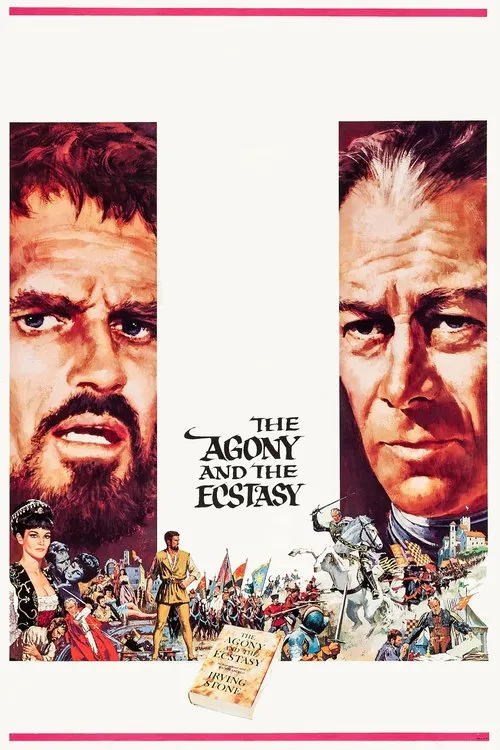The Agony and the Ecstasy

Plot
The Agony and the Ecstasy, directed by Carol Reed in 1965, is a historical drama film that delves into the tumultuous relationship between Pope Julius II and the renowned Renaissance artist Michelangelo. The film serves as an adaptation of Irving Stone's 1961 novel of the same name, exploring the intriguing and intense collaboration between a fiercely demanding pope and a creative genius like Michelangelo. The story commences in the early 16th century, when the ambitious Pope Julius II (played by Rex Harrison) seeks to leave an enduring legacy. To achieve this ambitious goal, he selects Michelangelo (played by Charlton Heston), the celebrated sculptor and painter of his time, to create a grand tomb worthy of his own reputation and status. The commission consists of 40 intricate statues, which Michelangelo accepts, only to be met with the realization that a project of this scale and complexity would require time and attention he hadn't anticipated. However, in an abrupt turn of events, Pope Julius II abruptly changes his plans, compelling Michelangelo to leave his sculptures unfinished. The new project – a monumental mural painting inside the Sistine Chapel – tests the artist's resolve. Initially, Michelangelo questions the possibility of his own artistic capabilities to accomplish such an enormous undertaking, leading to his temporary abandonment of the project. This abandonment is the result of Michelangelo's deep-seated insecurity regarding his artistic skills. Having made his name as a sculptor, he wonders if his experience in painting could possibly equal his mastery of marble. Moreover, he becomes aware of the daunting expectations of the pope and the pressures to meet them. This fear of failure becomes a recurring theme throughout the film, influencing Michelangelo's decisions and actions as he navigates this tumultuous creative partnership. However, fate eventually intervenes, nudging Michelangelo back towards the Sistine Chapel. With renewed inspiration and creative fervor, he embarks on a challenging journey to realize his artistic vision. However, this journey becomes increasingly complex as Michelangelo's artistic style clashes with the expectations of the demanding Pope Julius II. Throughout the film, the tension between Michelangelo and the pope escalates. The pope's fixation on a majestic fresco is matched by Michelangelo's unwavering commitment to his artistic ideals. While Julius II wants to be celebrated through Michelangelo's masterpiece, the artist sees his creation as a testament to his artistic genius rather than the pope's ego. As the story unfolds, this intense clash between artistic vision and the pressures from the church leadership becomes increasingly tense. In spite of Michelangelo's initial reluctance, his divine inspiration drives him forward. With his unyielding passion and focus, he channels his creative energy into a work of breathtaking beauty and genius. At its core, The Agony and the Ecstasy explores the intense emotional and artistic struggle of Michelangelo, highlighting the challenges faced by creative individuals operating within the boundaries of a rigid and structured institutional framework. The film showcases how his unwavering artistic dedication, inspired by a divine vision, ultimately prevails despite the obstacles presented by the demanding church leadership. In the end, The Agony and the Ecstasy presents a profound and thought-provoking portrayal of the intricate dance between artistic expression and the social pressures that often influence it. This cinematic masterpiece not only showcases the artistic genius of Michelangelo but also offers a window into the intense struggles faced by artists throughout history.
Reviews
Recommendations




